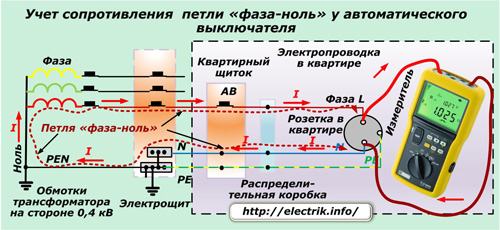Categories: Automata and RCD
Number of views: 36546
Comments on the article: 3
How currents are taken into account for circuit breakers
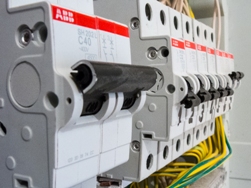 The current passing through the circuit breaker is determined by Ohm’s well-known law by the value of the applied voltage, referred to the resistance of the connected circuit. This theoretical position of electrical engineering is the basis for the operation of any machine.
The current passing through the circuit breaker is determined by Ohm’s well-known law by the value of the applied voltage, referred to the resistance of the connected circuit. This theoretical position of electrical engineering is the basis for the operation of any machine.
In practice, the mains voltage, for example, 220 volts, is supported by automatic devices of the energy supplying organization within the standards stipulated by state standards; it varies slightly within this range. Going beyond GOST is considered a malfunction, an accident.
The circuit breaker cuts into the phase wire of the power supply of lamps, sockets and other consumers. When the electric shaver is first fed from the outlet, and then the washing vacuum cleaner, then in both cases a current flows through the machine in a closed circuit between phase and zero.
But, in the first case it will be relatively small, and in the second it will be significant: these devices differ in resistance. They create a different load. Its value is constantly monitored by the protection of the machine, carrying out its shutdown when abnormal.
How current flows through the circuit breaker
Structurally, the machine is designed so that the current acts on sequentially located elements. These include:
-
wire connection terminals with clamping screws;
-
power contacts with a mobile and stationary part;
-
bimetal thermal release plate;
-
short circuit current shutoff electromagnet;
-
connecting current leads.
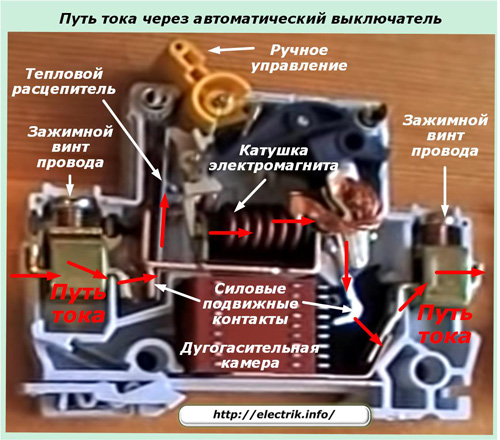
The current path through the circuit breaker is shown in the picture by conventional red arrows.
The movable power contacts are pressed against the stationary ones, creating a continuous electrical circuit only after the operator manually rotates the control lever. A prerequisite for inclusion is the absence of emergency situations in the switched circuit. If they appear, then protection immediately starts working on automatic shutdown. There is no other way to turn on the machine.
But breaking these contacts by de-energizing the supply of phase potential to consumers can be done in two ways:
-
manually, returning to the initial position the control lever;
-
automatically from triggering protections.
How structural elements of a circuit breaker are created and work
Power contacts
They, like the entire design of the circuit breaker, are designed to transmit strictly limited power. It is impossible to exceed it, because in the opposite case, the machine will fail - it will burn.
The technical characteristic limiting the maximum power passing through the power contacts is an indicator called “Ultimate Breaking Capacity”. It is denoted by the index "Icu".
The value of the ultimate breaking capacity of the circuit breaker is set when designing it from a standard series of currents, usually measured in kiloamperes. For example, Icu may be 4 or 6, or even 100 or more kA.
This value is indicated directly on the front side of the machine, as well as other characteristics of the settings of the current values.
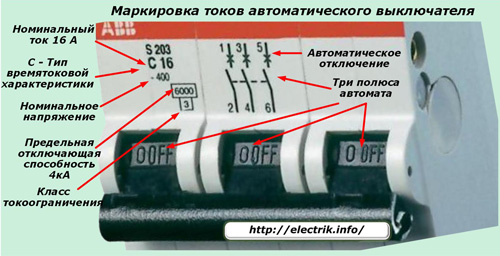
So, through the power contacts of the machine shown in the picture, an electric current from zero to 4000 amperes can safely pass. The AB itself will normally withstand it and turn it off in the event of an emergency inside the connected wiring with consumers.
For this purpose, a distinction has been introduced between the currents flowing through power contacts into:
1. nominal and working;
2. emergency, including overload and short circuits.
What is the rated current of the circuit breaker
Any machine is created to work under certain technical conditions. It must reliably ensure the passage of the operating load current flowing both through the electrical wiring and through the connected consumers.
When choosing an automatic machine for a household network, users often take into account the conductive properties of the wiring or only the power of electrical appliances, making a mistake: it is necessary to comprehensively analyze both of these issues. For, a switch is an automatic device that is already adjusted to operate when certain current values are reached.
When these conditions have not yet arrived, and the working current through the machine is less. than the lower limit of disconnection, the power contacts are reliably closed. The upper limit of this operating range is usually called the rated current, denoting In.
The number “16” shown in the picture means that the currents passing through the power contacts, up to and including 16 amperes, will be reliably transmitted by the circuit breaker to the connected consumers via electric wires.
This is a function of the machine itself. And the owner of the electrical installation and the service electrician have a completely different task - to choose the correct circuit breaker for the load and wiring in the complex. Indeed, when these 16 amperes are exceeded, disconnections from protections will occur, which are configured to operate from various currents that are “tied” by electrical algorithms to the nominal value. Read more about this here -Selection of circuit breakers for an apartment, house, garage
How protection works
All currents greater than the rated value trigger the protections. They are called tripping currents, denoted by Iav.
For automatic shutdown inside the machine’s case, two types of devices mounted according to different shutdown principles are mounted:
1. heating and bending the bimetal with the withdrawal of the mechanical latch from the mesh;
2. knocking out the latch with a mechanical shock by the core of the electromagnet.
Thermal release
It works due to the bending of the bimetallic composite plate when heated by the current passing through it, and is cooled by heat removal to the environment.
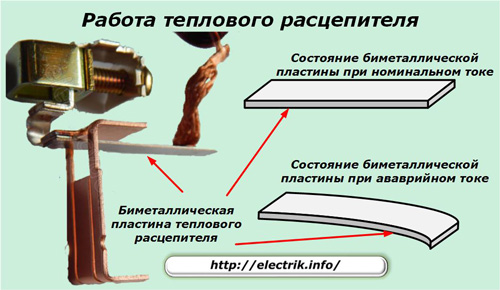
Thermal energy generated by electric current through the passing bimetal is applied to this release. Its value, as we know from the Joule-Lenz law, depends on:
1. electrical resistance of the circuit;
2. current flowing strength;
3. and the time of its impact.
Of these three parameters, the electrical resistance in the steady state process does not practically change. It is taken into account only in theoretical calculations. With load switching, the current changes abruptly. Therefore, two other parameters are more important:
1. the magnitude of the electric current;
2. time of its course.
They are taken into account special features, which are called by these components - time-current.

By the strength of the current flowing through the machine and the time of its action, not only the zone of operation of the thermal release, but also the electromagnetic cut-off is determined.
The basis of the calculations is the value of the rated current selected for the circuit breaker design. The operation of the protections is tied to its multiplicity - the ratio of the passing current to the rated current.
Since the current protections of the circuit breaker operate in excess of the rated current, the current multiplicity is always I / In> 1.
Electromagnetic cutoff
The protection work is based on the constant accounting of currents passing through the turns of the electromagnet windings. When the magnitude of the loads does not exceed the calculated nominal value, the currents flowing in each turn create a total magnetic field that is not able to overcome the holding force of the mechanical rod inside the solenoid housing.
The head of the movable pusher is pulled inward, and the movable power contact of the circuit breaker is firmly pressed to the stationary part.
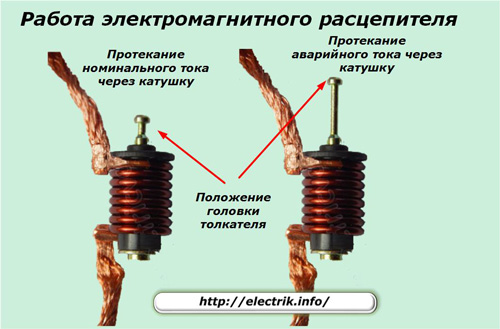
When the strength of the passing current exceeds the rated current of the setpoint, the total magnetic field formed inside the coil will abruptly overcome the rod holding force. He shoots and with a sharp blow hits the latch, pulls it out of gear.
As a result of the strike, the movable power contact of the circuit breaker is sharply discarded by mechanical energy from the stationary one - the electric circuit is broken, and the supply voltage is removed from the connected circuit.
How are circuit breaker protections configured?
In order for the machine to clearly withstand the rated current without creating false positives, its protection is tuned to the calculated values.
Thermal release
When choosing the standard current setting, the nature of the connected load is taken into account and calculated according to the formula Iust = kr ∙ kn ∙ In, where kr = 1.1, and kn takes into account operating conditions. It is set within:
-
1.1 ÷ 1.3 for circuits with short-term overloads from starting electric motors or similar devices;
-
1,1 - for resistive circuits without overload or for the operation of direct current circuits.
As an example, consider the protective characteristic of the thermal release of an old A3120 circuit breaker.
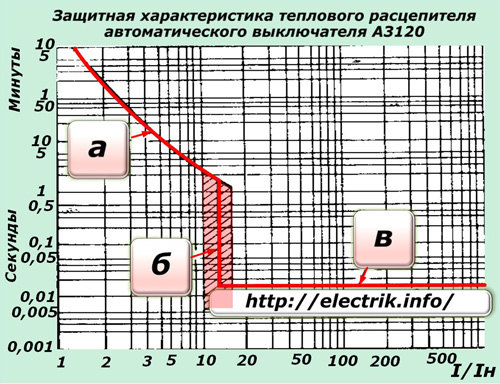
In the current section from 1.3 to 10 times the In characteristic is represented by the curve “a”, the operation is performed with a time delay, which creates a reserve of work for connected electrical appliances. With an increase in load, their shutdown time decreases from a few minutes to one second.
At a tenfold load, the A3120 thermal release deactivates the power contacts with a time of about 0.01 seconds with a small variation in the parameters shown in the graph by the light red color zone. Over ten times the increase in operating currents cannot accelerate the protection due to the mechanical properties of the circuit breaker design.
Electromagnetic cutoff
The parameters of the time-current characteristic for the electromagnetic cut-off organ are also adjusted according to the rated current. In household machines, the instantaneous trip current is divided into three classes:
1. In, lying within 3 ÷ 5 In;
2. С - 5 ÷ 10 In;
3. D - 10 ÷ 20 In.
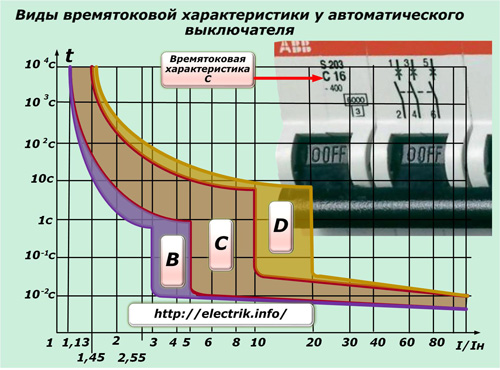
For industrial technical devices, circuit breakers with classes are created:
-
A, triggered at lower currents than 3In;
-
E and F - at greater multiples than 20In within various limits.
The described class of work of domestic automatic machines is legalized by the requirements of GOST R 50345—2010. Foreign manufacturers also use a similar division of instantaneous cutoffs, but current standards and shutdown times may vary, stipulated by the standards of their countries or IEC 60947-2.
Current limiting class
The speed of the instantaneous current protection of the circuit breaker is tied to the frequency of the sinusoidal harmonic of the industrial network and is indicated by one of the numbers: 1, 2 or 3. This figure shows the part of the half-wave of the standard harmonic during which the trip should occur.
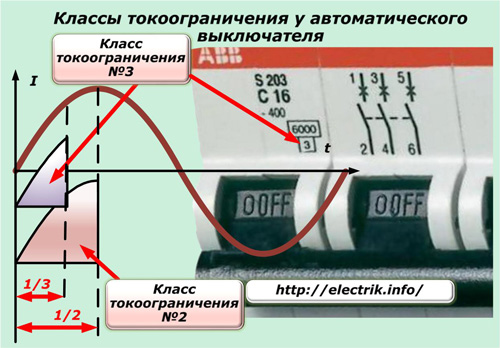
The current-limiting machine 3 is the fastest - it will work in 1/3 of the half-cycle. Characteristic 2 indicates its half, and 1 - the full length of the half-wave.
Conditions for limiting currents passing through a circuit breaker
An important point in the operation of circuit breakers operating on load currents is the consideration of the circuit connected to them, which already has some specific resistance. Its value will limit the operation of the cutoff in emergency mode, and at some point it will not allow timely removal of the supply voltage from damaged equipment.
An example of such a section is the active resistance of the winding of the source of the supply transformer with all connected cores of cables and wires of the electrical network, assembled on terminal blocks and clamps of junction boxes and panels up to the contacts of the apartment outlet. Its experts call loop phase zero.
To take into account its value with the correct setting and operation of the circuit breaker, special devices are used - resistance meters of this loop.
Their measurement allows you to take into account the correction introduced by the additional resistance of the wires, which means that you can accurately take into account the currents passing in emergency mode through the power contacts and circuit breaker protections.
How the circuit breaker is checked for currents passing through it
After manufacturing, the products of any manufacturer can be transported over long distances or stored in warehouses for a long time before being installed in an electrical circuit. During this time, a decrease in its quality is possible due to a violation of technical characteristics.
Therefore, circuit breakers, when installed in a circuit before it is put into operation, must undergo a health check, which is usually called loading.

For this purpose, a special scheme for loading the machine is assembled in the electric laboratory or one of the many designs of stationary or portable stands is used.
The circuit breaker is checked for the rated current indicated on the housing. It must withstand its value for a long time.
Then the machine is subjected to overloads and short circuit currents, which it must withstand during operation. At the same time, they are clearly measured and recorded:
1. operation currents of thermal release protections and current cutoff;
2. times off the machine from the moment of simulation of an emergency.
Some designs of machines allow you to adjust the output parameters during loading. For example, certain types of thermal releases have a screw mount, which allows you to adjust the setpoint for the operation of the bimetallic plate within certain limits.
All measured characteristics are recorded with high accuracy by measuring instruments and are recorded in the verification protocol, compared with the requirements of GOST. After their analysis, a certificate with a conclusion on suitability is issued.
Loading the machine under load allows you to identify marriage, prevents cases of possible fires and electrical injuries.
Thus, the currents passing through the circuit breakers are taken into account in the design, production, testing and operation. For this, the terms are taken into account that are required by GOST:
-
rated current;
-
overload;
-
short circuit current;
-
trip current protection;
-
fault shutdown time.
See also at bgv.electricianexp.com
:

